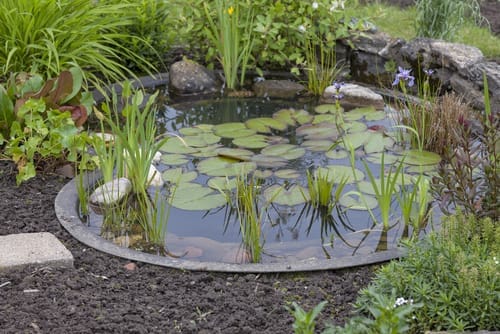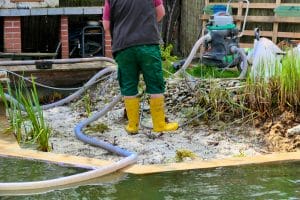What Causes Pond Water to Smell Bad & How to Fix It
A smelly pond can be more than just an annoying issue; it can also be a sign of deeper problems that need to be addressed to restore water quality, aesthetics, and the overall health of your pond. Whether you use your pond as a decorative feature in your garden, a habitat for local wildlife, or a recreational space, maintaining a fresh-smelling pond is essential for everyone’s enjoyment. In this article, we’ll explore why pond water smells bad, how it affects your pond’s ecosystem, and the steps you can take to fix it.
The Science of Smelly Water
Pond water odors are caused by a combination of factors that disrupt the natural balance of the ecosystem. One of the primary culprits is organic decay. As plants, leaves, fish waste, and other organic material decompose, it releases gases such as methane and hydrogen sulfide. These gases can create unpleasant smells, especially when oxygen levels in the water are low. Additionally, bacteria play a significant role in the production of these odors. While some bacteria help break down organic material in a healthy pond, an overgrowth of harmful bacteria can lead to the production of foul-smelling compounds.
The lack of oxygen in pond water encourages the growth of anaerobic bacteria, which thrive in low-oxygen environments and produce sulfur-based gases. The interplay of bacteria, organic decay, and oxygen levels is a key factor in what makes pond water smell bad.
The Role of Ecosystem Imbalance
A healthy pond should be a self-sustaining ecosystem, where plants, fish, and beneficial bacteria work together to maintain water quality. However, when this balance is disrupted—whether through overfeeding, chemical imbalances, or stagnant water—bad smells can begin to emerge. A pond with an unbalanced ecosystem is more prone to the growth of harmful bacteria and algae, both of which contribute to unpleasant odors.
An ecosystem imbalance can occur when there’s too much organic waste, insufficient circulation, or poor water quality. This leads to the rapid breakdown of organic material, which results in the release of foul-smelling gases. It’s essential to address these imbalances quickly to prevent further degradation of the pond environment.
How Different Smells Indicate Different Issues
Pond water odors can vary depending on the specific issue at hand. Here are a few common smells and what they typically indicate:
- Rotten Egg Smell: This odor is usually caused by anaerobic bacteria producing hydrogen sulfide, a gas that has a distinctive rotten egg smell. This typically happens when the pond water lacks sufficient oxygen, often due to stagnant water or excessive organic decay.
- Fishy Odor: A fishy smell often accompanies algae blooms or high ammonia levels. Algae growth can deplete oxygen levels, creating an environment where harmful bacteria thrive, releasing compounds that give off a fishy smell.
- Sewage-Like Smell: This odor is usually a sign of excessive organic waste accumulating in the pond, such as fish waste or decomposing plant material. It may also indicate stagnant water where organic material isn’t breaking down efficiently, leading to the buildup of unpleasant smells.
Common Causes of Smelly Pond Water
If you’ve noticed a persistent bad odor coming from your pond, there are several common causes you should consider. Let’s explore some of the key factors that contribute to smelly pond water.
Hidden Organic Decay
One of the most common causes of smelly pond water is the accumulation of hidden organic decay. Over time, small debris such as dead plants, leaves, and fish waste settle to the bottom of the pond. If this material isn’t removed, it begins to decompose, releasing gases like methane and hydrogen sulfide. These gases are responsible for that rotten egg smell that often plagues ponds with poor circulation.
As organic material continues to break down, it creates a thick layer of sludge on the bottom of the pond. This sludge acts as a breeding ground for harmful bacteria, which further exacerbate the odor. Left unchecked, this organic waste can cause long-term problems with pond water quality.
Microbial Overgrowth & Bacterial Imbalances
In a healthy pond, beneficial bacteria help break down organic material and maintain water quality. However, an imbalance in the bacterial population can lead to unpleasant odors. Excessive sludge and organic matter can encourage the growth of anaerobic bacteria, which thrive in low-oxygen environments. These bacteria produce sulfur-based gases like hydrogen sulfide, resulting in foul odors.
To prevent microbial overgrowth, it’s important to maintain proper pond circulation and aeration. This ensures that oxygen levels remain high enough to support beneficial bacteria while limiting the growth of harmful anaerobic bacteria. Adding beneficial bacteria treatments can also help improve water quality by promoting the breakdown of organic waste.
Chemical Imbalances in Water
Pond water can develop chemical imbalances due to various factors, including excessive nutrients like nitrogen and phosphorus. These nutrients often come from fertilizers, decaying organic matter, or fish waste. When there’s an overload of nutrients in the pond, it creates an ideal environment for algae growth. Algae blooms consume oxygen and release compounds that can cause fishy odors or other unpleasant smells.
In addition to nutrient overload, improper pH levels can contribute to odor issues. If the pH is too low (acidic) or too high (alkaline), it can affect the pond’s overall water quality and promote the growth of odor-causing bacteria. Regular water testing can help you monitor your pond’s pH levels and adjust them as necessary.
Weather & Seasonal Changes
Seasonal changes and weather conditions can have a significant impact on pond odors. In hot summer months, pond water tends to warm up, which decreases the oxygen levels and encourages anaerobic conditions. This can lead to the production of sulfur-based gases and contribute to the foul, rotten egg smell.
Another weather-related issue is seasonal turnover. This occurs when the temperature difference between the top and bottom layers of the pond water causes a mixing of layers, known as overturning. During this process, trapped organic material and gases at the bottom of the pond are stirred up, releasing odors into the water. Seasonal turnover is especially common in ponds with poor circulation and can lead to a sudden spike in bad smells.
How to Fix and Prevent Bad Pond Odors
Restoring the health of your pond starts with a few key strategies. In this section, we’ll dive into practical ways to fix and prevent bad odors by addressing the root causes and enhancing the overall environment of your pond.
Improve Aeration
One of the most common causes of bad pond odors is low oxygen levels. Without sufficient oxygen, anaerobic bacteria thrive, producing smelly gases like hydrogen sulfide. To combat this, consider:
- Installing Aerators or Fountains: Adding an aerator or fountain is one of the simplest and most effective methods to boost oxygen levels. By continuously circulating water, these devices help to infuse oxygen throughout the pond. This increased oxygenation not only discourages the growth of odor-producing anaerobic bacteria but also supports beneficial aerobic organisms that aid in water purification.
- Using Bottom Diffusers: For larger ponds or those with significant depth, bottom diffusers can be very effective. They deliver air directly into the lower layers of the pond, ensuring that oxygen reaches areas that might otherwise be neglected.
Regular Pond Cleaning
Even with good aeration, accumulated debris and decaying organic matter can lead to persistent odors. Regular maintenance is crucial to keep your pond clean and odor-free.
- Debris Removal: Routinely skim the surface of your pond to remove leaves, twigs, and other debris before they sink and begin to decay. Consider using a pond net or skimmer to make the process easier.
- Sediment Management: Over time, sediment builds up at the bottom of your pond. This sediment can harbor decomposing matter and anaerobic bacteria. Periodically removing or stirring up the sediment can help prevent these odors. If sediment accumulation is a recurrent issue, consider a professional sediment removal service to thoroughly clean your pond’s floor.
Balancing Fish & Plant Life
A healthy pond ecosystem relies on a balanced interaction between fish, plants, and microorganisms. When one element overpowers another, it can lead to imbalances that cause odors.
- Proper Fish Stocking: Overcrowded ponds often suffer from increased waste production, which contributes to organic buildup. Make sure that your pond isn’t overstocked with fish. Too many fish produce too much waste, which can quickly degrade water quality.
- Incorporating Aquatic Plants: Aquatic plants play a vital role in absorbing excess nutrients from the water. Plants such as water lilies, reeds, and floating plants not only enhance the beauty of your pond but also help maintain its chemical balance. They reduce the likelihood of harmful algae blooms by competing for nutrients and sunlight.
- Creating a Balanced Ecosystem: A well-balanced pond should have enough fish to control algae through natural grazing while still keeping waste levels manageable. The right mix of aquatic vegetation can also provide natural filtration, absorbing excess nutrients that might otherwise fuel odor-causing bacteria.
Using Beneficial Bacteria
Not all bacteria are bad. In fact, beneficial bacteria are essential for breaking down organic waste in your pond.
- Natural Waste Breakdown: Introducing beneficial bacteria into your pond can help break down decaying matter before it produces offensive odors. These bacteria work by converting harmful ammonia and nitrites into less harmful nitrates, thereby maintaining water quality.
- Commercial Bacterial Treatments: Many pond supply stores offer bacterial supplements that are designed to boost the natural cleaning power of your pond. Regularly adding these supplements—especially after heavy rain or a significant increase in organic debris—can keep your pond’s ecosystem in balance.
Improving Water Circulation
Stagnant water is a major contributor to pond odors. Without proper circulation, organic matter settles and decays, releasing unpleasant smells.
- Installing Pumps and Waterfalls: Water pumps and small waterfalls help to keep the water moving, preventing stagnation. A continuous flow of water not only discourages the formation of odor-causing anaerobic zones but also enhances the overall aesthetic appeal of your pond.
- Dual Circulation Systems: In larger ponds, consider a dual-circulation system that ensures both surface and deep water are well circulated. This helps prevent the buildup of sediments in the deeper parts of the pond and maintains a consistent oxygen level throughout.
- Regular Maintenance of Equipment: Ensure that your pumps, filters, and other circulation equipment are regularly maintained and functioning properly. Malfunctioning equipment can lead to uneven water flow and create pockets of stagnant water where odors can develop.
When DIY Methods Aren’t Enough – Calling in Experts
While many pond issues can be managed with regular maintenance and a few DIY fixes, there are times when the problem is too severe or complex. In these cases, it’s important to know when to call in professional help to save your pond and restore its natural balance.
Signs That Your Pond Has a Serious Water Quality Problem
Even with consistent DIY efforts, some symptoms indicate that your pond might be suffering from deeper issues that require expert intervention.
Persistent Foul Odors Despite Multiple Interventions
If you’ve tried improving aeration, cleaning regularly, and balancing your ecosystem, yet the foul odors persist, it may be a sign that there’s an underlying issue that isn’t being addressed. Chronic smells often point to severe oxygen depletion or a significant buildup of anaerobic bacteria, conditions that can be difficult to rectify without professional diagnostics and treatment.
Sudden Fish Deaths or Extreme Algae Blooms
Another red flag is the sudden death of fish or the rapid development of algae blooms. These events are strong indicators of serious water quality issues, such as toxic ammonia levels, low oxygen content, or the presence of harmful chemicals. In these cases, immediate professional assessment is crucial to identify and resolve the problem before it further harms the ecosystem.
What Professionals Can Offer That DIY Can’t
When DIY methods fall short, a pond specialist brings a range of advanced tools and expertise to diagnose and treat the issue effectively.
Advanced Water Testing
Professional pond services can conduct thorough water quality tests that measure critical parameters such as oxygen levels, ammonia, pH balance, and nutrient concentrations. These tests provide a clear picture of what is causing the odor and help in devising a targeted treatment plan. While DIY test kits are available, professionals use more precise and reliable equipment to get an accurate assessment.
Deep Sediment Removal and Dredging Techniques
In cases where sediment buildup is severe, a professional may recommend deep sediment removal or dredging. This process involves physically removing the layers of accumulated organic matter from the bottom of the pond. Not only does this improve water quality, but it also prevents the reoccurrence of odors by eliminating the primary source of decay.
When to Consider a Complete Pond Overhaul
Sometimes, the issues plaguing your pond are so ingrained that minor fixes won’t be sufficient. A complete pond overhaul might be necessary, particularly if the design or structure of the pond is contributing to the problem.
Structural Issues Contributing to Stagnant Water
If your pond’s layout inherently leads to stagnant water, no amount of regular cleaning or aeration will fully solve the problem. Structural flaws such as uneven grading, poor drainage, or an inappropriate shape can create areas where water fails to circulate properly. In such cases, a complete redesign of the pond may be warranted to ensure that water flows evenly throughout.
Regrading and New Drainage Systems
For older ponds or those with design issues, regrading (reshaping the pond’s contours) or installing new drainage systems can make a significant difference. These changes help prevent the formation of stagnant zones and facilitate better water flow, ensuring that the pond’s ecosystem remains balanced. Although these solutions may involve a higher upfront cost, the long-term benefits of improved water quality and reduced maintenance requirements are well worth the investment.
Conclusion
If your pond continues to emit unpleasant odors despite your best DIY efforts, it might be time to call in professional help. Aqua Pond Ltd. has over 30 years of experience in pond cleaning, maintenance, repair, and construction across Bedfordshire and surrounding areas. They specialize in transforming problematic ponds with services such as debris removal, algae control, and water quality management. In addition, they offer pond repair, liner replacement, and custom water features—including waterfalls, fountains, and aquatic gardens—using high-quality Evolution Aqua Pond products.
Don’t let a smelly pond ruin your outdoor space. Take action today by reaching out to experts who can restore your pond’s natural balance and enhance its beauty.
For inquiries or to schedule a service, contact Aqua Pond Ltd. at 01525 552150 or email info@aquapond.co.uk. Visit their website and use the contact form for more details. Enjoy a clear, odor-free pond and a vibrant aquatic environment!
Related Posts
- The Fastest Way to Cycle a Koi Pond: Expert Tips for a Healthy Habitat
- Newts for Ponds: Unlocking the Magic of Newts and Enhancing Your Pond with These Fascinating Creatures
- Water Fountain Service
- Pond Cleaning & Maintenance Service Bedfordshire
- 17 Common Koi Fish Diseases To Look Out For In Garden Ponds: A Comprehensive Guide
- Pond Maintenance Plans: Which One Is Right for You? An In-Depth Guide to Tailored Options for Every Homeowner
- What are Marginal Pond Plants? Understanding Their Role and Benefits in Aquatic Ecosystems
- Spring Pond Prep: Essential Checklist for a Thriving Summer Environment



